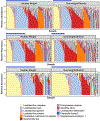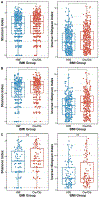The vaginal microbiome in women of reproductive age with healthy weight versus overweight/obesity
- PMID: 34806323
- PMCID: PMC9070090
- DOI: 10.1002/oby.23306
The vaginal microbiome in women of reproductive age with healthy weight versus overweight/obesity
Abstract
Objective: The aim of this study was to evaluate the differences between the vaginal microbiome of reproductive-aged women with overweight and obesity (Ow/Ob) compared with healthy weight (HW).
Methods: In this case-control study, a cohort of 367 nonpregnant women (18 to 40 years) with Ow/Ob (BMI ≥25 kg/m2 ) was case-matched with 367 women with HW (BMI 18.0 to 24.9 kg/m2 ). The study was a secondary analysis of 16S rRNA vaginal microbiome surveys through the Vaginal Human Microbiome Study (VaHMP). Groups were matched on age, race/ethnicity, income, and nulliparity status.
Results: Mean age and BMI of Ow/Ob and HW groups were 26.8 versus 26.7 years and 37.0 versus 22.1 kg/m2 , respectively. The overall vaginal microbiome composition differed between groups (PERMANOVA, p = 0.035). Women with Ow/Ob had higher alpha diversity compared with women with HW (Wilcoxon test, Shannon index p = 0.025; inverse Simpson index p = 0.026). Lactobacillus dominance (≥30% proportional abundance) was observed in a greater proportion of women with HW (48.7%) compared with Ow/Ob (40.1%; p = 0.026).
Conclusions: The vaginal microbiome differs in reproductive-aged women with Ow/Ob compared with women with HW, with increased alpha diversity and decreased predominance of Lactobacillus. Observed differences in the vaginal microbiome may partially explain differences in preterm birth and bacterial vaginosis risk between these populations.
© 2021 The Obesity Society.
Conflict of interest statement
Competing Interests:
All authors declare no financial conflicts of interest.
Figures



Similar articles
-
Pre-pregnancy weight, gestational weight gain, and the gut microbiota of mothers and their infants.Microbiome. 2017 Sep 4;5(1):113. doi: 10.1186/s40168-017-0332-0. Microbiome. 2017. PMID: 28870230 Free PMC article.
-
Vaginal microbiome in early pregnancy and subsequent risk of spontaneous preterm birth: a case-control study.BJOG. 2019 Feb;126(3):349-358. doi: 10.1111/1471-0528.15299. Epub 2018 Jun 27. BJOG. 2019. PMID: 29791775
-
Early pregnancy vaginal microbiome trends and preterm birth.Am J Obstet Gynecol. 2017 Sep;217(3):356.e1-356.e18. doi: 10.1016/j.ajog.2017.05.030. Epub 2017 May 23. Am J Obstet Gynecol. 2017. PMID: 28549981 Free PMC article.
-
Vaginal microbiome in obesity and its impact on reproduction.Best Pract Res Clin Obstet Gynaecol. 2023 Aug;90:102365. doi: 10.1016/j.bpobgyn.2023.102365. Epub 2023 Jun 13. Best Pract Res Clin Obstet Gynaecol. 2023. PMID: 37399714 Review.
-
The Vaginal Microbiome in U.S. Black Women: A Systematic Review.J Womens Health (Larchmt). 2020 Mar;29(3):362-375. doi: 10.1089/jwh.2019.7717. Epub 2020 Feb 28. J Womens Health (Larchmt). 2020. PMID: 32109181
Cited by
-
Microbiome-Maternal Tract Interactions in Women with Recurrent Implantation Failure.Microorganisms. 2025 Apr 7;13(4):844. doi: 10.3390/microorganisms13040844. Microorganisms. 2025. PMID: 40284680 Free PMC article. Review.
-
Early prediction of preeclampsia using the first trimester vaginal microbiome.bioRxiv [Preprint]. 2024 Dec 2:2024.12.01.626267. doi: 10.1101/2024.12.01.626267. bioRxiv. 2024. PMID: 39677801 Free PMC article. Preprint.
-
Scoping Review of Microbiota Dysbiosis and Risk of Preeclampsia.Am J Reprod Immunol. 2024 Oct;92(4):e70003. doi: 10.1111/aji.70003. Am J Reprod Immunol. 2024. PMID: 39440917
-
Diverse vaginal microbiota in healthy Japanese women: a combined relative and quantitative analyses.Front Cell Infect Microbiol. 2025 Feb 4;14:1487990. doi: 10.3389/fcimb.2024.1487990. eCollection 2024. Front Cell Infect Microbiol. 2025. PMID: 39967801 Free PMC article.
-
Longitudinal profiles of the vaginal microbiota of pre-, peri-, and postmenopausal women: preliminary insights from a secondary data analysis.Menopause. 2024 Jun 1;31(6):537-545. doi: 10.1097/GME.0000000000002358. Menopause. 2024. PMID: 38787353 Free PMC article.
References
-
- Crovesy L, Masterson D, Rosado EL. Profile of the gut microbiota of adults with obesity: a systematic review. Eur J Clin Nutr. 2020;74(9):1251–1262. - PubMed
Publication types
MeSH terms
Substances
Grants and funding
LinkOut - more resources
Full Text Sources
Miscellaneous

